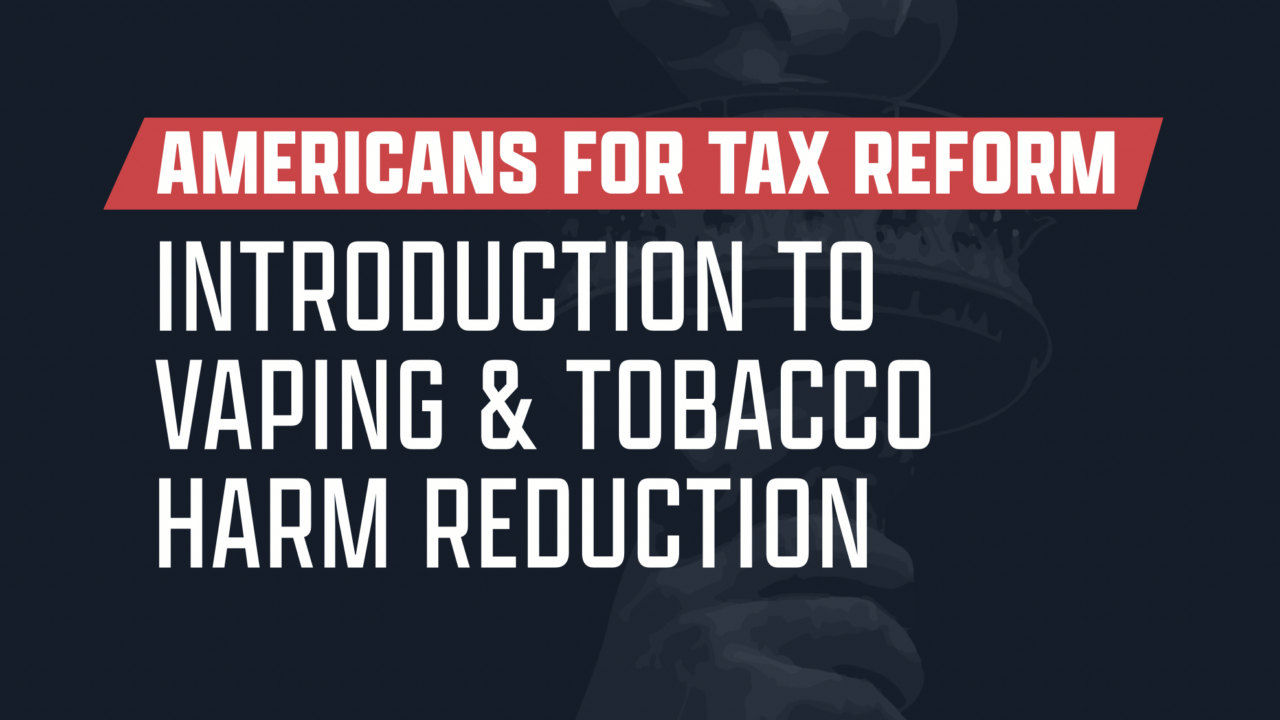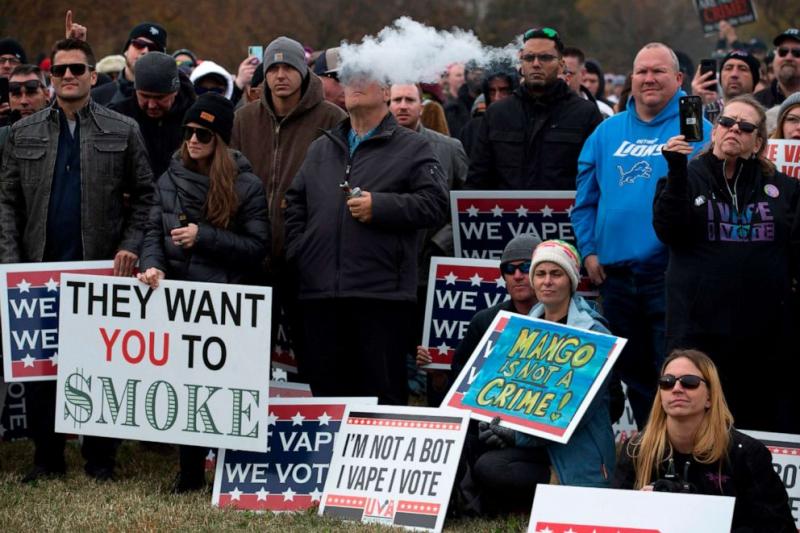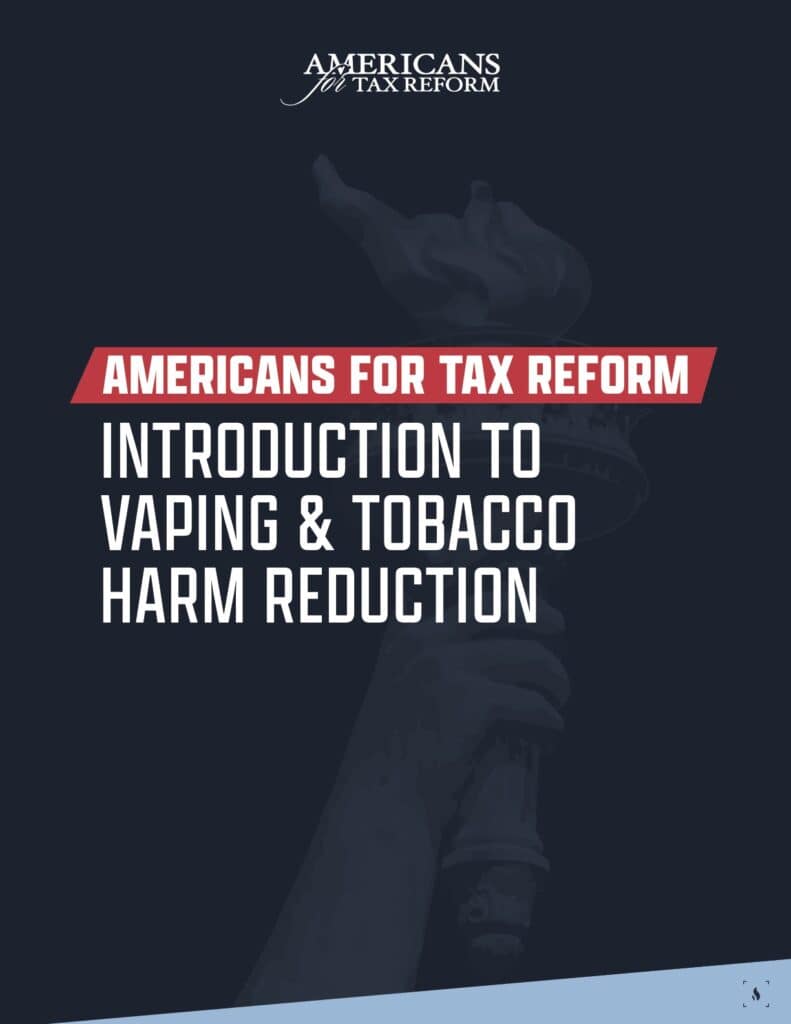
Welcome to ATR.org/VapeFacts, your go-to guide to understanding vaping, why it matters, and how restrictive government policies can have devastating consequences.
Americans for Tax Reform unapologetically advocates for tobacco harm reduction and promotes policy that minimizes the negative health and legal effects of cigarette smoking. Vaping saves lives, yet legislatures and health officials continue to push for obsolete prohibitions that are proven to have harmful economic and criminal justice ramifications. ATR is proud to lead the fight for tobacco harm reduction.
Click Here to Download Americans for Tax Reform’s 35-Page Introduction Packet on Vaping and Tobacco Harm Reduction.

What is Vaping?
Vaping products, often called e-cigarettes or vapes, are 21st century technological developments that deliver nicotine to users through an aerosol, or vapor, rather than smoke.
Unlike traditional nicotine replacement therapies, like gum or patches, vaping mimics the habitual nature of smoking. This has made e-cigarettes the premier product for smoking cessation across the world. To learn more about vaping, check out ATR’s Vaping One Pager here.
Is Vaping Safer than Smoking?
Yes, vaping is scientifically shown to be significantly less harmful than combustible cigarettes!
A review performed by Public Health England of available scientific evidence on e-cigarettes found that vaping is approximately 95% less harmfulthan cigarettes.
A research report published in European Addiction Research estimated the harms of nicotine-containing consumer products and identified e-cigarettes as having about 4% of the harm of cigarettes.
Is Nicotine Harmful?
Nicotine is not what produces the negative health effects of cigarettes. Nicotine is highly addictive, but relatively benign, much like caffeine. According to the UK’s Royal College of Physicians, nicotine does not cause “clinically significant short- or long- term harms”.
The harm from cigarettes comes from the combustion, or burning, process that produces thousands of chemicals, including cancer-causing carcinogens.
Does Vaping Help Smokers Quit?
A study published in the journal Addictive Behaviors Report found that someone attempting to quit smoking with an e-cigarette has a 323% higher chance of achieving complete cessation than someone using a traditional nicotine replacement.
Vaping is shown to be the single most effective method of getting smokers to quit.
Is there a Youth Vaping “Epidemic”?
Anti-vaping advocates often references a “youth vaping epidemic” as justification for vaping restrictions like flavor bans or tax hikes. This claim is largely exaggerated.
CDC data shows that youth vaping has plummeted by 60% over the past two years. As of 2021, only 3.1% of high-school age and 0.3% of middle-school age students used e-cigarettes daily.
Compare that to the 14.4% of 12-20 year-olds who reported binge drinking in the last month. Approximately 5,000 under-21 Americans die every year from underage drinking. Not a single person has ever died from vaping nicotine liquid.
Why do Flavors Matter in Vaping Products?
For those trying to quit smoking, a sweet or fruity non-tobacco flavor can be essential. Flavored vapes are highly popular among adult users.
A study from the journal Nicotine & Tobacco Research found that someone trying to quit smoking with a flavored vape was 43% more likely to quit than someone using unflavored or tobacco-flavored vapes.
Access to flavored vaping products increases the likelihood that an adult cigarette smoker will quit the deadly habit of cigarette smoking. Flavors are shown to not increase the likelihood of adolescent vaping. Youth are shown to have the same willingness to try plain versus flavored vaping products.
What Happens when Flavored Vapes are Banned?
Bans on flavored vaping products can have horrific consequences for public health and state tax revenues.
In San Francisco, a ban on flavored vaping products led to youth smoking rates more than doubling. In 2019, a year after the ban was imposed, youth smoking in San Francisco was 6.2%, compared to 2.8% in comparable cities.
Flavor bans heavily impact state tax revenues. After Massachusetts imposed a ban on flavored vapes and tobacco products, the state has lost over $10 million a month in excise tax revenue to neighboring states.
To learn more about flavored vaping products and the impacts of flavor bans, check out ATR’s Flavored Vape One Pager here.
What are the Impacts of Vaping Tax Hikes?
Tax hikes on vaping products directly lead to increased cigarette smoking.
A study from the National Bureau of Economic Research found consistent evidence that taxes on e-cigarettes increase smoking rates, thereby leading to more tobacco-related deaths. In Minnesota, a tax hike on vaping prevented 32,000 adult smokers from quitting.
It is estimated that if Minnesota’s tax hike was imposed on a national level, 1.8 million less American smokers would quit over the next ten years. Further, should federal e-cigarette taxes be made equal to cigarette taxes, smoking would increase 8.1% nationwide.
To learn more about the consequences of vaping tax hikes, check out ATR’s Vape Tax One Pager here.
Do Medical Organizations Support Vaping?
Over 100 of the world’s leading scientific and public health organizations have publicly confirmed vaping as safer than smoking. Many of these groups also endorse vaping as a method of smoking cessation.
The organizations includes the Royal Australian College of Physicians, the Government of Canada, the Belgian Superior Health Council, the French National Academy of Medicine, the German Society of Addiction, New Zealand’s Ministry of Health, the British Medical Association, and 15 past-Presidents of the Society for Research on Nicotine & Tobacco Research. The full list of groups and their statements can be read here.
What Other Reduced-Risk Alternatives to Smoking Exist?
Many Americans are most aware of vaping products, but they are not the only product proven to decrease smoking-related harm. While abstinence from nicotine is the healthiest choice, ATR recognizes that, for many smokers, quitting completely is incredibly difficult. For these people, reduced-risk alternatives have immense potential to improve health.
Snus, a form of “clean” Swedish smokeless tobacco, is popular among Swedish men and is the reason why they have the lowest rate of lung cancer in the developed world. The U.S. Food and Drug Administration allows certain snus products to be marketed as putting the user at a lower risk of mouth cancer, heart disease, lung cancer, stroke, emphysema, and chronic bronchitis.
Heat-not-burn products (HNBs) heat tobacco to produce a vapor which reduces a user’s exposure to harmful chemicals present in smoke. In Japan, where HNBs recently became popular, smoking has decreased by 43%.
Nicotine pouches are completely tobacco-free and contain only nicotine, food-grade ingredients, and plant fibers. They contain only trace-levels of harmful chemicals and less toxicants than snus.
To learn more about alternative nicotine products, check out ATR’s Tobacco Alternatives One Pager here.


